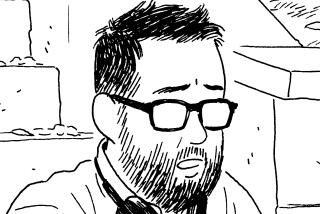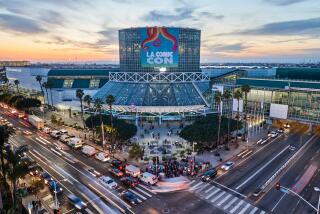Remembering Los Angeles as a hotbed of alt-weekly comics
In the early 1980s, comics were as much a part of Los Angeles alternative culture scene as independent film and punk rock. That’s gone now, but here, comics historian Ben Schwartz takes a look back.
None of them knew each other. They saw one another’s comics in ‘zines, weeklies and punk newspapers. “Yeah, there were a number of us,” remembers Matt Groening, 30 years after his strip “Life in Hell” debuted in the Los Angeles Reader. “I don’t think we even considered it a ‘scene.’ It just felt like a bunch of people in isolation.”
“We knew nobody in comics when we started,” concurs Jaime Hernandez. He, along with his brother Gilbert (and sometimes brother Mario) self-published their seminal indie comic “Love & Rockets” in 1980. For them, as for Groening and others, comics were a passion, if not a career. “I never thought I was good enough to make money at it,” says Groening. For filmmaker David Lynch, who produced the four-panel strip, “The Angriest Dog in the World,” from 1983 to 1992, it was a fluke. “I have zero love of cartoons,” he says today. The Hernandez Brothers were high school punk rockers in Oxnard not sure what they would do after high school; Gary Panter, creator of the comic “Jimbo,” was a fine arts painter.
Yet the wrok these artists produced helped launch the Los Angeles comics scene in the 1980s, one of the liveliest in the country and still flourishing today.
“Something was happening in a town that had millions of palm trees and looks cool and shouldn’t be there,” says Panter from his home in Brooklyn. “It helped us meet friends and find an audience for what we were trying to do in isolation.”
That isolation inspired Groening to draw when he moved here in 1977. “I grew up in the Pacific Northwest,” he says. “And Los Angeles in particular seems to me like a parched desert. I just wasn’t used to the climate, the smog, the traffic and the lack of money. So I was pretty miserable, and I took it out in my little self-published comic book. I was able to put it together because I worked in a photocopy store on Wilshire Boulevard near the La Brea Tar Pits. So I called it ‘Life in Hell.’”
Self-publishing was necessary because there was no other venue for a strip about two rabbits mulling life and love. The underground comics scene of the 1960s was a thing of the past. The syndicated alt weekly world, which Groening eventually helped establish, didn’t exist yet for local cartoonists.
Still, nationwide, the proliferation of small record labels and ‘zines suggested a new set of possibilities. “Comics are relatively easy to produce, as was punk music,” says Gilbert Hernandez. “So fed-up creative people saw a window open for a new order of self-expression.”
“Jimbo” appeared in Slash, the punk newspaper. After he saw “Life in Hell,” Panter wrote Groening a fan letter that led to their friendship. Like Groening’s confused bunnies, Jimbo was a wide-eyed naïf trying to navigate L.A. Created in Texas in 1973, the character coalesced in Southern California, Panter feels, because of Slash.
“It was natural that I would draw a punky lead character,” he says, “And that from the cast of characters I had invented up to that point, he seemed the right guy. He’d had a pompadour in Texas. He cut it off and became a punk.”
Groening and Panter went to shows, finding themselves drawn to Black Flag, Fear, the Screamers (for whom Panter designed a logo) and Devo. There was anger but also humor in songs such as “TV Party” and “I Love Living in the City.” Pee-wee Herman’s early performances featured a somewhat ruder persona than would later appear on “Pee-wee’s Playhouse.” (Panter designed sets for both his live and TV shows.)
Lynch first drew his absurdly enraged dog in 1973, although he wouldn’t publish it for years. “During ‘Eraserhead’ I did a drawing of a dog that looked just like the one in the cartoons,” he recalls. “It just popped out. I don’t know if humor comes out of trouble, but it seemed like a troubling time. A lot of violence and a lot of drugs and Hollywood Boulevard falling into hell.”
By 1980, Groening had taken a job as an assistant editor at the Reader, whose editor, James Vowell, loved “Life in Hell” and gave Groening a back page. In addition to being cartoonist-in-residence, Groening’s duties also included paste-up, writing a music column and delivering the paper on Thursdays.
“One of the most gratifying things about doing a comic strip,” he says, “was that Gary Panter and I used to walk down the street and were thrilled if we saw a newspaper in the gutter and our strips were in the drain water. We’d say, ‘Oh, my God, we’re part of the landscape!’”
On trips down from Oxnard, the Hernandez brothers liked what they saw. “We had seen Panter’s work in Slash,” says Gilbert, “and thought it was funny. Same with ‘Life in Hell,’ and both being creator-owned and critically appreciated work, that gave us more ammo for our comics ambitions.”
The Hernandez brothers took this in their own direction. The lead characters in “Love & Rockets” were two Oxnard teen lesbian punks, Maggie and Hopey. “That’s what was happening in my life at the time,” recalls Jaime. “It was a very vibrant era for me and a perfect subject to put into my comics.”
By the early 1980s, Groening was something of a comics tastemaker. After he wrote about Lynda Barry, the Reader’s parent publication, the Chicago Reader, began to run her strips, which still appear nationwide. In 1982, Groening brought Panter’s “Dal Tokyo” to the Reader — he also credits Panter’s influence on Lisa Simpson’s jagged edge haircut — and in 1983, he argued for the paper to pick up “The Angriest Dog in the World.”
Some people were skeptical. Lynch’s strip — which featured the same four panels week in and week out — became an unintentional joke on comics such as “Garfield,” which often did run the same image three times in a strip and changed only the dialogue.
“There are certain rules to the dog,” Lynch explains. “The only thing that changed was the dialogue, and I learned to like that concept. The dog never moves, never changes. He’s so bound up with tension and anger that he approaches a state of rigor mortis. I needed to show a passage of time. and so it just seemed correct to do three-day shots and a night shot.”
For the next nine years, that was it. “Every Monday I called it ‘dog day.’ I had to come up with a dog.” Lynch told the Reader what the word balloons should say and where they came from (the house, over the fence). “Just in the air. There was one, ‘Houston, the Eagle has landed.’ It was funny to me.”
By the mid-1980s, the scene began to grow beyond itself. After Art Spiegelman completed the first volume of his groundbreaking Holocaust graphic memoir “Maus,” he recommended Groening to his publisher, Pantheon, which agreed to take him on. Groening had already self-syndicated “Life in Hell” (and other strips) into 60 papers nationwide and published a collection, “Love in Hell,” which sold 22,000 copies.
Meanwhile, Panter was designing Emmy Award-winning sets for Pee-wee Herman. “Love & Rockets” inspired the indie comics movement like nothing since the 1960s Zap! underground. As for Lynch, his directing work has always been acclaimed. But nine years in, the Reader killed his dog.
Today, the L.A. scene remains close to the spirit of 1980. Groening and Panter appear in the local “Kramers Ergot” anthology, edited by Sammy Harkham, but with the alternative weeklies dying out, local talents such as Johnny Ryan, Steven Weissman, Jordan Crane, Joe Matt and Esther Pearl Watson are more likely to appear in books. Four-panel gag-meisters Kaz, Carol Lay and Tony Millionaire still create weekly strips but also work in animation and illustration.
“L.A. attracts cartoonists to work in animation and such,” says Gilbert Hernandez, who now lives in Las Vegas. “But there’s also the feeling of great potential for creating something new in comics because things move so much there. It never stands still.”
Schwartz is the editor of the book “The Best American Comics Criticism.” He has written for the New York Times, the Washington Post and Bookforum.
More to Read
The biggest entertainment stories
Get our big stories about Hollywood, film, television, music, arts, culture and more right in your inbox as soon as they publish.
You may occasionally receive promotional content from the Los Angeles Times.










